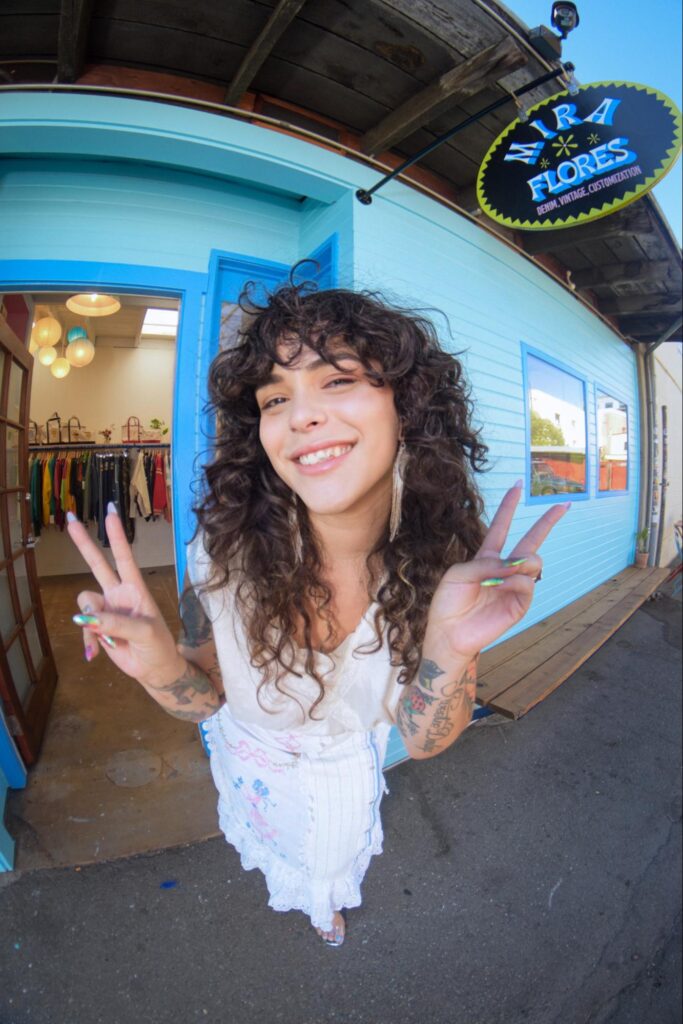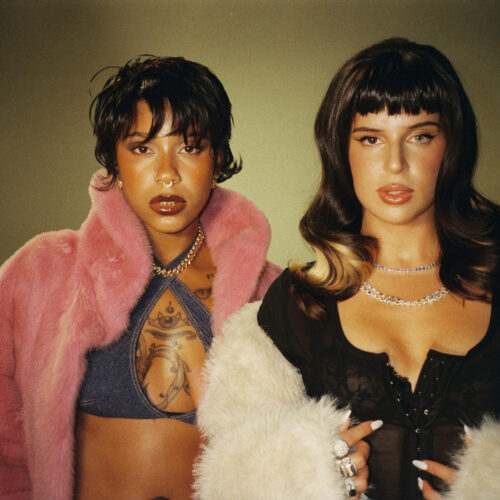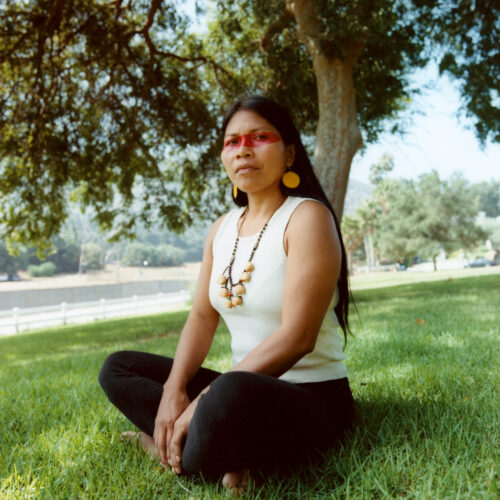Samantha Saavedra chain stitches with a hundred-year-old Singer sewing machine. What began as a tailoring stint at Levi’s led to running a business out of her home. Then, in 2022, Saveedra opened Mira Flores, a retail and tailor shop specializing in chain stitch embroidery and denim repair. For the artist, embroidery is like tattooing. The needle slowly marks textiles as Saavedra hand cranks and directs the machine where to draw. With every customization, she blends the visual traditions of chain stitch embroidery and old school tattooing, while taking inspiration from her home-city, Lima, Peru.
We caught up with the Oakland-based artist to discuss the debut of her workwear line, and her recent brick-and-mortar expansion.

Samantha Saavedra photographed by Jazmine Carranza.
Could you briefly introduce yourself?
My name is Samantha, I am the head tailor and owner of Mira Flores. My new workwear line has tags that say ‘Made in Peru, designed in Oakland.’ I feel like if I had a tag, it would say ‘Made in Peru and designed in San Francisco/Oakland.’ I was born in Arizona and moved with my mom to Lima, Peru when I was 3. I grew up there until I was 20. I wanted to get out of Lima so badly. I was a rebellious teenager and didn’t want to do what my mom told me. I came [to the Bay Area] not knowing much. I just knew that Full House was filmed here and that was pretty much it. I studied at the Art Institute of San Francisco, and it shaped me into the creative that I am today. In the early 2010’s, kids my age were going to art school, running around the Mission District, going to art shows, and hanging out at the Phone Booth.
How did you get your start in chain stitch embroidery?
I was working at a restaurant and my coworker got a job at Levi’s as a tailor. She comes to work one day and she [shows us what she did at Levi’s.] And I saw that it was chain stitch. I remember thinking, ‘That is so cool. I want to do that.’ It sparked my creative light bulb. I ended up getting a job at Levi’s but they wouldn’t let me touch the embroidery machine for the first eight months. I had to pay my dues and do all the hems and tapers, and repair all the nasty crotches from denim nerds that never wash [their jeans]. As soon as I got my hands on that embroidery machine, my friend Gillian, who got me the gig, and I began making crazy pieces. I was already really into tattooing, and already a drawer. I remember we were asking headquarters, ‘Can we do a display for Christmas?’ We would do these crazy pieces on these jackets, and they asked us, ‘Wait, you can do things like that with a machine?’
There seem to be some parallels with tattooing and chain stitching.
Chain stitching is like tattooing on clothes. The first time I heard that it was from a tattoo friend who saw me do embroidery. You’re freehanding, manually guiding the machine where to go. I have a lot of traditional American style tattoos too. So, when I was first learning, I would practice with traditional roses, you know, imagery that is simple and solid, with minimal shading.
How would you describe your aesthetic now?
I love lettering and roses, so I reference vintage signs and tattoo culture a lot. I also love drawing naked women. It’s been my own discovery of liberation. People were, like, ‘Free the nipple.’ I was like, ‘Let’s draw naked women.’ Even when I find a reference and they‘re fully-clothed, I’m always, ‘Yeah, no, naked.’
Where do you find inspiration these days?
Lately, I’ve been looking more into my roots. I’ve lived in [the U.S.] for 13 years, and I discovered all this art that’s distinctly American. But since COVID, I began missing my family and I wanted to reconnect. In Peru there is so much culture that I am only now starting to appreciate. Now, when I go back home, I realize, ‘Oh, all the bus signs are hand painted. All the fisherman boats are hand painted. That’s so cool!’ My partner and I got a sign painted by a guy that does all the fisherman boats in this tiny little town outside of Lima. I grew up in Peru, and I felt some resentment towards it. A lot of love too, but a lot of resentment. I never fit in. But I’m an adult now. I know who I am. Let’s look at Peru and think, how can we get inspired and love this place again?
How has this newfound appreciation for Peru influenced your work?
My store is actually named after the neighborhood that I grew up in Lima. Mira Flores is an homage to who I am and who I’ve been running away from. In the last few years, I started looking back and really being proud and loving where I came from. So I think people are going to start seeing a change in my art.
Tell me about your line of clothing that you’re producing in Peru.
Once we had the store, I had all these ideas of what I wanted to design. I was sourcing other brands, workwear shirts.. I thought, ‘Why don’t we create our own?’ My dream has always been to do workwear for femme bodies. I started working with a really good friend that works in Gamarra, the fashion garment industry of Lima. It was important for me to find factories that were not sweatshops, so. I went to see the factories, and they’re in great condition and treat their employees well.

Samantha Saavedra photographed by Jazmine Carranza.
You are re-opening your store in a new, larger location. What prompted the move?
The first space gave us what we needed for the first year. It was amazing, but it [was] too small. I’m a Pisces, so I dream big. I imagine all the amazing things we can do. People [would] be waiting for an hour to try clothes on on a busy day. I also wanted to bring in more vendors because not only do we customize garments that come into the shop, we also create a space for other artists and makers to sell their own items. I always wanted a space where artists could connect with their customers and with other artists. Us artists, we sometimes don’t value our craft or it’s scary to ask for what we want and need. So I want a store where artists can value their work and people can meet those artists. The bigger space is to be able to do social events and have more fitting rooms.

Samantha Saavedra photographed by Jazmine Carranza.
How do you balance your creativity with running a business?
I am a workaholic. I’m not gonna lie. Some of my friends have my [phone] location, and they’re like, ‘Girl, it’s three in the morning, you’re still at the store?’ or ‘You’re in the studio?’ I just love what I’m doing but I am trying to ask for more help. I can’t do it all myself, and you kind of have to spend money to make money. That’s been literally what I’ve had to do in the last six months. I’ve been just like, ‘It’s okay. Like we can totally pay this person and ask for help and it’s going to give me more time to think creatively.’
What advice would you give someone thinking about starting a business or getting started on a creative endeavor?
Do not listen to that tiny little voice that is trying to bring you down. You don’t need a business plan. I didn’t have one. And always reach out for help. Reach out to your community because those are the people that are going to be your biggest supporters. 80% of the people that I know now came from my early years in San Francisco and they have been my biggest supporters throwing my name out there to other people. I started a crowdfunding campaign for my store through Kiva, and my mom came in and sent an email to [practically every] person that has ever met me. [Many responded], ‘I haven’t seen you since you were a baby, but your mom told me to support you.’
Joanna García Cherán is an art historian, writer and cultural worker passionate about art of our time.









